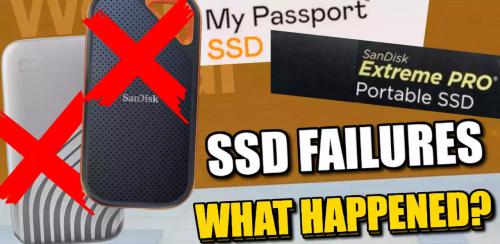Five Signs of SSD Failure that You Shouldn't Ignore: Tips to Prevent Data Loss From SSD Failure

Solid-state drives are data storage devices like hard disks but differ in their technology and performance. SSDs use flash memory for data storage, offering faster read/write speeds, durability, and energy efficiency. HDDs use spinning disks and are slower but offer higher storage capacities.
Nowadays, solid-state drives (SSDs) have become the popular choice for data storage due to their speed and reliability. However, they are not invincible, and like any electronic device, SSDs can fail over time. Recognizing the early signs of SSD failure is important for preventing data loss and ensuring the longevity of your data storage.
In this article, we'll discuss five warning signs of SSD failure and provide tips on how to prevent data loss.
Five Signs of SSD Failure that You Shouldn't Ignore
SSD (Solid-State Drive) failure can have significant impacts on us. It can result in the loss of valuable data, documents, photos, and videos. This data loss can disrupt work and lead to financial or emotional stress. To prevent it from happening, we need to act on time, and for this, we need to check the signs that our SSD provides us regularly.
Here are five signs of SSD Failure that you shouldn’t ignore-
1. Data Corruption
One of the earliest signs of an upcoming SSD failure is data corruption. If you notice files becoming corrupted or unreadable without any apparent reason, your SSD may be struggling.
Data corruption can manifest as files failing to open, displaying strange characters, or becoming inaccessible. Don't dismiss these issues as normal errors; they could be early signs of SSD failure.
2. Bad Blocks or Sectors
SSDs use wear-leveling technology to evenly distribute data across memory cells to prolong their lifespan. Over time, individual memory cells can wear out or become unstable, resulting in bad blocks or sectors. Monitoring your SSD for an increasing count of bad blocks is important, as it can indicate a deteriorating drive.
3. Sudden and Frequent Crashes or Blue Screens
If your computer experiences frequent crashes or displays the infamous "Blue Screen of Death" (BSOD), it could be due to SSD issues. SSD failures can cause system instability, resulting in crashes or BSOD errors. If these problems persist despite other troubleshooting efforts, it's a sign that your SSD may be at risk of failure.
4. Slow Performance or Slow Boot Times
SSDs are known for their speed, and when they're functioning correctly, they provide fast data access and faster boot times. But when an SSD nears the end of its life or encounters issues, you may notice a significant drop in performance.
Slow transferring of files, applications taking longer to load, and extended boot times are all signs of SSD failure. Don't dismiss these symptoms as normal aging; they could indicate a more serious problem.
5. SMART (Self-Monitoring, Analysis, and Reporting Technology) Warnings
Most SSDs come equipped with SMART technology, which monitors the drive's health and performance. When a significant issue arises, SMART will often trigger warnings that can be accessed through diagnostic tools.
These warnings may include reallocated sectors, uncorrectable errors, or temperature fluctuations. Regularly checking SMART data and heeding its warnings is a proactive way to detect SSD issues before they lead to catastrophic failure.
Tips to Prevent Data Loss From SSD Failure
While it's not possible to guarantee that an SSD (Solid-State Drive) will never fail, there are several measures you can take to significantly reduce the risk of data loss from SSD failure.
1. Regularly Back Up Your Data: Maintain frequent data backups to external drives or cloud storage services. This ensures that even if your SSD fails, your important files remain safe.
2. Monitor SSD Health: Use SMART tools and manufacturer-provided software to keep an eye on your SSD's health. Identifying issues early allows for timely action.
3. Update Firmware and Software: Keep your SSD firmware and operating system up to date.
4. Avoid Overfilling Your SSD: Leave at least 20% of your SSD's capacity unused to allow for wear-leveling and maintain optimal performance.
5. Prevent Overheating: Ensure your computer is adequately cooled to prevent overheating, which can lead to SSD degradation. Clean the dust from the cooling fans regularly.
6. Use Dependable Power Sources: Protect your SSD from power surges or outages by using a quality uninterruptible power supply (UPS) or surge protector.
7. Handle Your SSD with Care: Avoid dropping or physically damaging your SSD. SSDs are sensitive to physical shocks.
Conclusion
Solid-state drives have transformed the world of data storage, offering speed and reliability. However, they are not infallible and can experience failures over time. Recognizing the warning signs of SSD failure is essential for safeguarding your data and avoiding unexpected downtime.
If you encounter any of the five signs mentioned above, it's important to act promptly. Back up your data, check SMART data, and Consult us at Techchef Data Recovery to solve the issue.
Post Your Ad Here
Comments